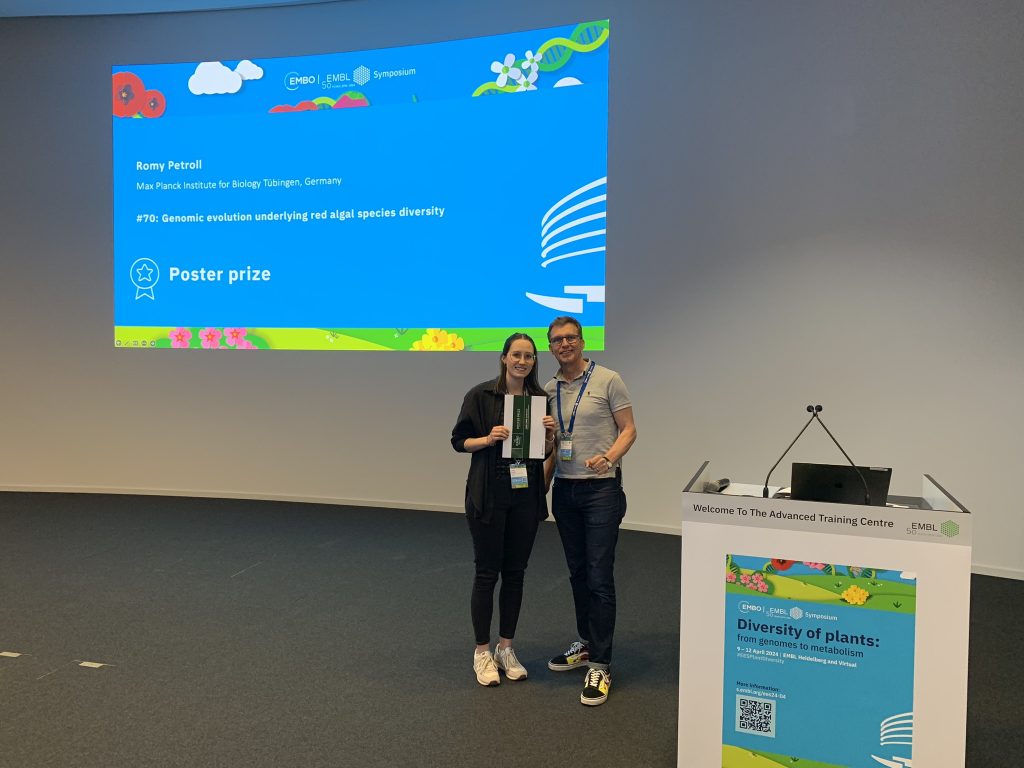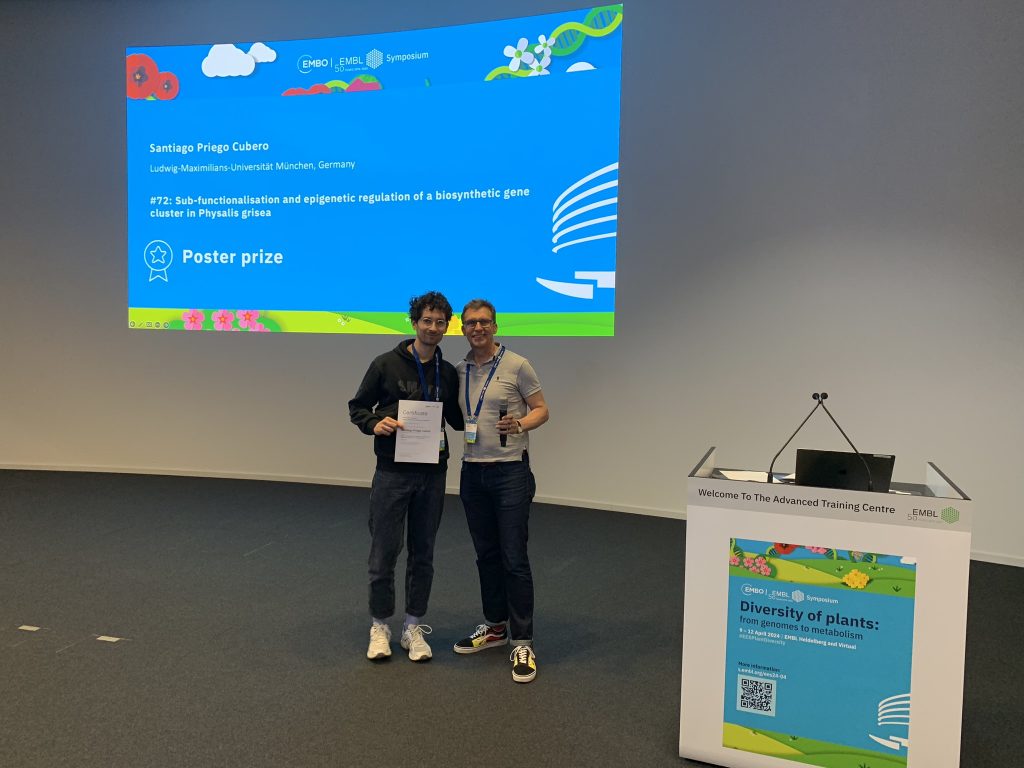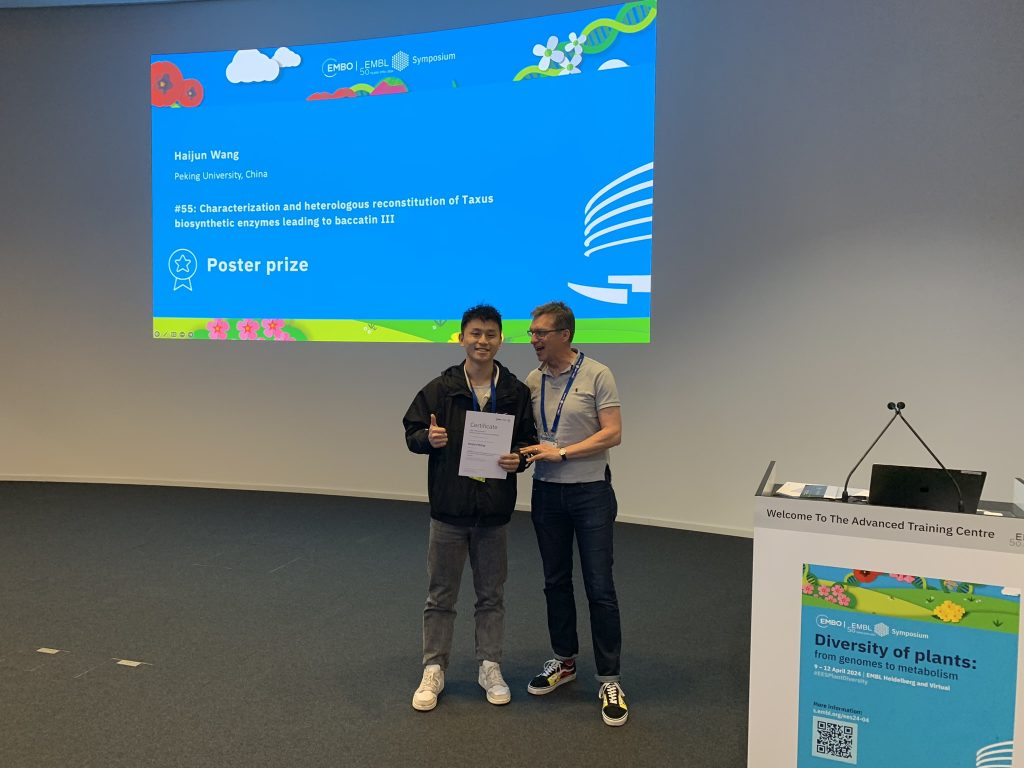Meet the poster prize winners of the EMBO | EMBL Symposium: ‘Diversity of plants’
In April 2024 we had the pleasure of hosting the inaugural edition of the EMBO | EMBL Symposium ‘Diversity of plants: from genomes to metabolism’ at the Advanced Training Centre in Heidelberg. The new community flourished together during the four days of top-notch talks, coffee breaks and poster sessions with lots of networking, and social activities such as the pub quiz and spectacular conference party!
The conference aimed to showcase the future of plant biology, and it certainly delivered. The topics covered included:
- Evolution of genomes
- Evolution of metabolism
- Biology of genomes
- Plants in their environment
- Evolution of phenotypes
Four winners received best poster prizes for their outstanding work in the field, and we are delighted to introduce you to three of them. Congratulations to Romy, Santiago, and Haijun!
Genomic evolution underlying red algal species diversity
Presenter: Romy Petroll, Max Planck Institute for Biology Tübingen, Germany
Collaborator: Michael Borg

Red algae belonging to the Florideophyceae class dominate species diversity in the Rhodophyta phylum and exhibit highly complex morphologies and reproductive processes that support a fascinating triphasic life cycle. Theory has it that the common red algal ancestor experienced some form of evolutionary bottleneck that led to a dramatic reduction in genomic content. Our analysis of genome size variation across the red algae suggests at least three origins of secondary genome expansion, one of which is traced to the emergence of the Ceramiales, which constitutes the most highly evolved and species-rich order of red algae. Despite their overwhelming diversity, contiguous high-quality reference genomes remain unavailable for the Ceramiales. In an effort to develop a novel model alga to study development and reproduction in red algae, we have generated the first chromosome-level genome assembly for a prominent member of the Ceramiales. This assembly is currently the largest red algal genome sequenced to date and the first at a chromosome-level for a species belonging to the Florideophyceae and Ceramiales. We aim to use this model system to characterize the molecular basis for genome size expansion in the Ceramiales, which we hypothesise to be a major source of genetic novelty underpinning the evolutionary success of this highly evolved and species-rich order. The insights gained from this burgeoning model organism are thus helping enlighten our understanding of the genomic evolution and adaptations driving red algal diversity.
Due to the confidentiality of the unpublished data, we cannot share the poster.

Sub-functionalisation and epigenetic regulation of a biosynthetic gene cluster in Physalis grisea
Presenter: Santiago Priego Cubero, Ludwig-Maximilians-Universität München, Germany
Collaborators: Eva Knoch, Philipp Chapman, Zhidan Wang, Arlen Slaymaker, Zhihui Bao, Karl-Heinz Braun, Saleh Alseekh, Alisdair Fernie, Chang Liu, Claude Becker

Withanolides are a diverse group of triterpenoids primarily found in species of the Solanaceae family. While withanolides act predominantly as herbivore repellents, their vast chemical diversity and biological activities make them promising candidates for sourcing nutraceutical compounds and pharmaceutical agents for treating a variety of human diseases. To date, only the enzyme catalysing the first committed step of the biosynthetic pathway, Δ24-isomerase (24ISO), has been identified, with subsequent pathway components remaining unknown. This represents a bottleneck towards the scalable production of withanolides and their pharmaceutical use. By mining the genome of the withanolide-producing Physalis grisea, we found 24ISO to be located in a potential biosynthetic gene cluster (BGC). Through tissue-specific co-expression analysis, we determined that this BGC is functionally divided into two contiguous subclusters: one exclusively expressed in roots, and one predominantly expressed in aerial tissues. Remarkably, both subclusters share a set of core genes, each including one 24ISO gene as well as genes belonging to families and subfamilies known to be involved in triterpenoid and terpenoid biosynthesis. These genes encode for CYP450s, 2-oxoglutarate-dependent (2ODD) oxygenases, short-chain dehydrogenases/reductases (SDRs), and sulfotransferases. This suggested a tissue-specific sub-functionalisation of the cluster, which was supported by the detection of tissue-specific withanolide composition. In line with a potential sub-functionalisation, we detected sub-cluster-specific and tissue-dependent DNA methylation and chromatin interaction signatures, suggesting that the tissue-specific expression of each subcluster is regulated at the epigenetic level. While the withanolide BGC is located at a basal position of the Solanaceae family, our data illustrate more generally how BGCs can functionally diversify across tribes within a family.
Due to the confidentiality of the unpublished data, we cannot share the poster.

Characterization and heterologous reconstitution of Taxus biosynthetic enzymes leading to baccatin III
Presenter: Haijun Wang, Peking University, China
Collaborators: Bin Jiang, Lei Gao, Yaping Sun

Paclitaxel is a well-known anticancer compound. Its biosynthesis involves the formation of a highly functionalized diterpenoid core skeleton (baccatin III) and the subsequent assembly of a phenylisoserinoyl side chain. Despite intensive investigation for half a century, the complete biosynthetic pathway of baccatin III remains unknown. Here, we identified a bifunctional cytochrome P450 enzyme (Taxane oxetanase, TOT) that catalyzes an oxidative rearrangement in paclitaxel oxetane formation, representing a previously unknown enzyme mechanism for oxetane ring formation. We created a screening strategy based on the taxusin biosynthesis pathway and uncovered the enzyme responsible for the taxane oxidation of the C9-position (T9αH). Finally, we artificially reconstituted a biosynthetic pathway for the production of baccatin III in tobacco.

The EMBO | EMBL Symposium ‘Diversity of plants: from genomes to metabolism’ took place 9 – 12 April 2024. Looking for another event which focusses on plants? The virtual course ‘Plant genomes: from data to discovery’ is open for applications until 1 September.